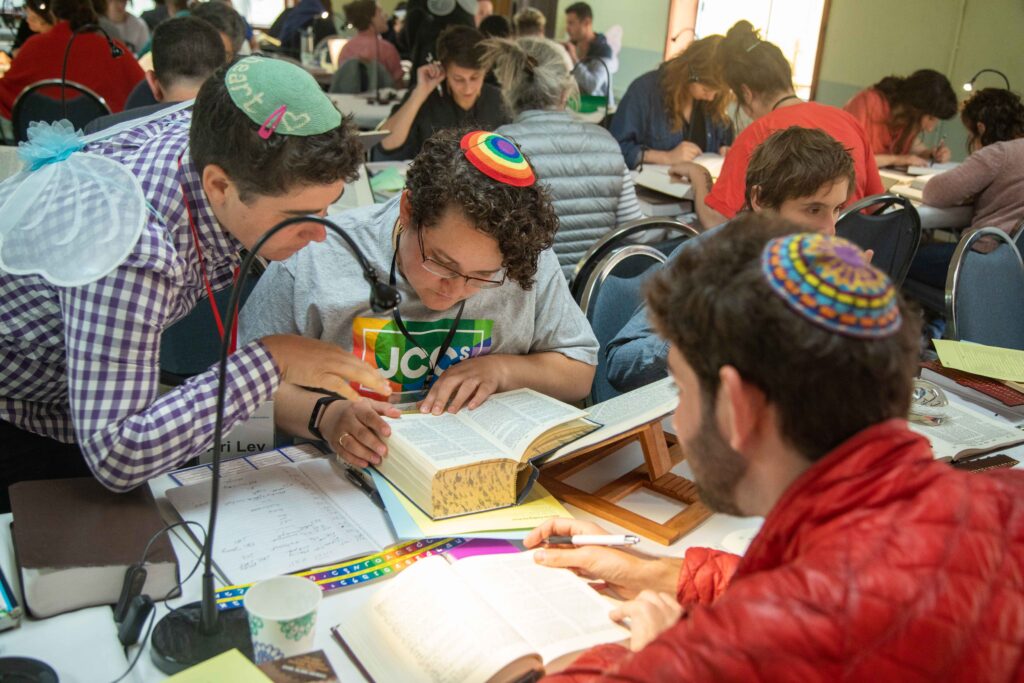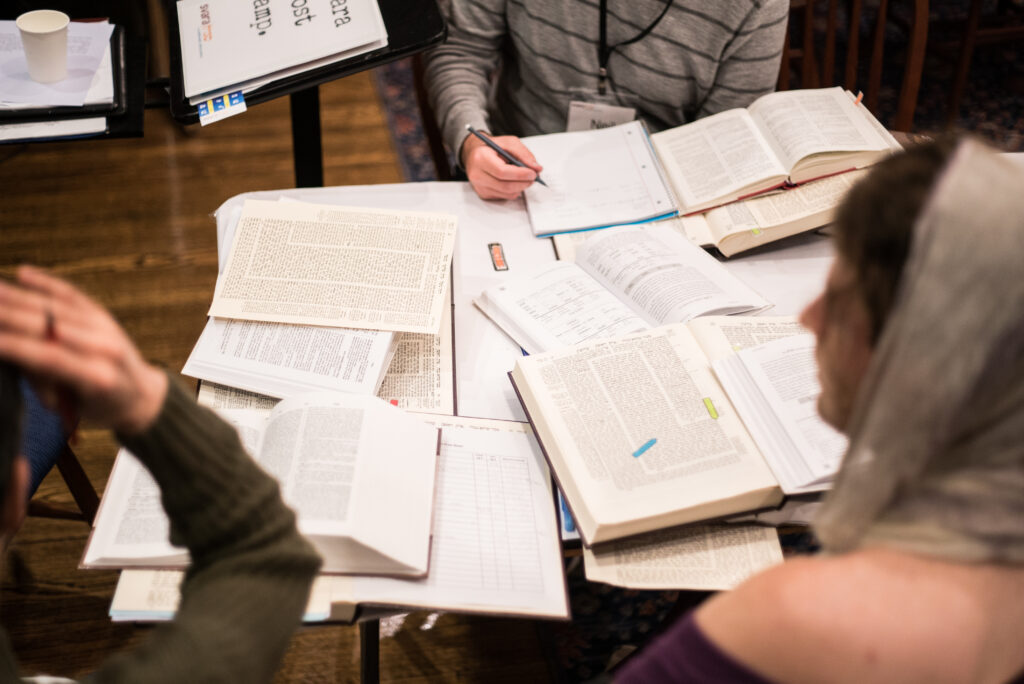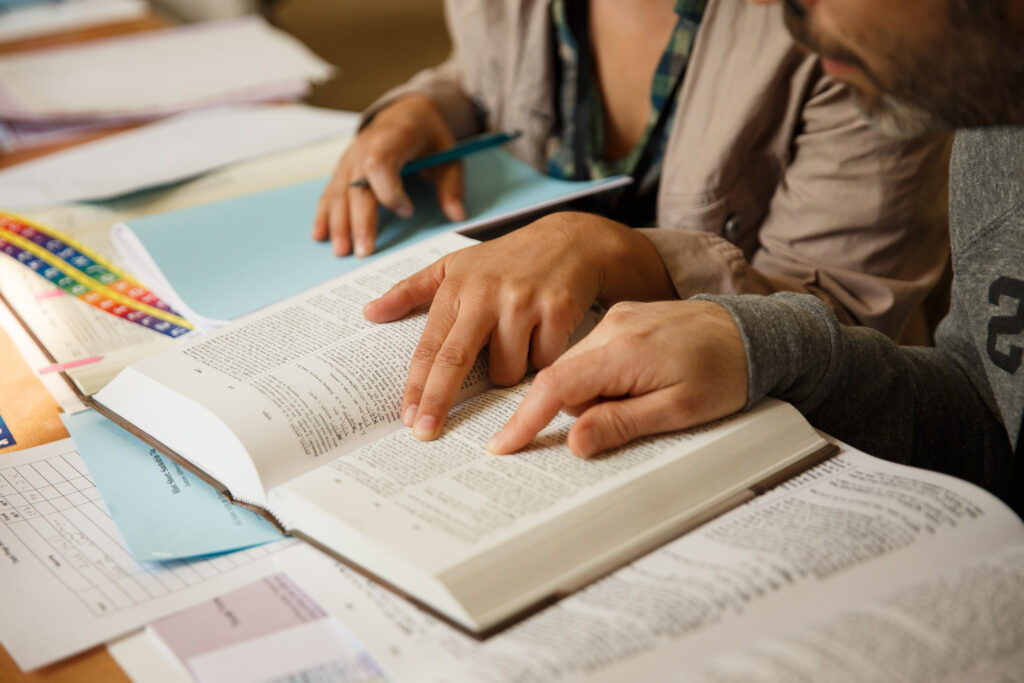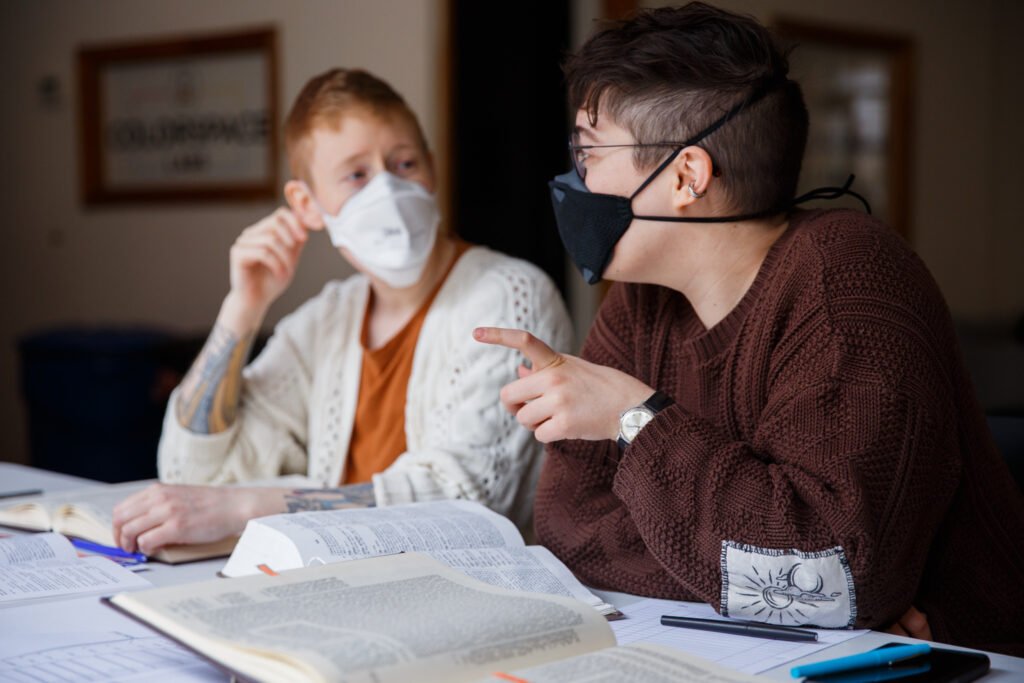As a member of SVARA’s teaching team, I get asked a lot of questions. Being in conversation with our learning community is one of the most life-giving parts of my work, and the questions I get help me feel closer to and more invested in our tradition. When y’all – our dazzling SVARA-niks – bring your questions to me (and hold my questions in return), I feel certain that curiosity is central to our queer rabbinic inheritance. There’s one question in particular I receive when teaching in the SVARA Bet Midrash that still keeps me up at night. No, it’s not, “‘Yentl’, I’ve never heard of that. Is she on TikTok?” (the children know better now not to come to Fairy Hours with me before doing their chazarah on all things Streisand). The question that haunts me is this: “Does the Talmud go far enough?”
At SVARA, we understand our study of the Talmud to be a process, a product, and a blueprint that is radical and revolutionary. But over the years I have had a learner, or several, who challenge this premise entirely and demand that we confront the slew of questions underlying what we do in the SVARA bet midrash—is the Talmud truly setting us up for success? Does it really imagine a plurality of voices entering the dialogue and discourse? Is it actually radical in scope, or are we just making it radical because we want to believe it to be so? And if we’re just reading into what we want to read into it, what happens when someone who doesn’t hold progressive values does the same? If you’re one of those learners who has asked these questions of me and you’re reading this now, it is because of you that I’ve lost sleep, and it is to you that I am deeply grateful.
I’m grateful to you who push back on what SVARA pedagogy calls our “Orientation” towards the text, which I would summarize as follows: the belief that our queer Talmudic ancestors were trying to invent something that was radically different than the Temple Judaism they inherited from their ancestors and that, so too, we stand in their lineage of working and wrestling to make the changes that we see in our time as necessary to the Judaism that we have inherited.
My gratitude to you, learners, who question this orientation towards Talmud, is that you’ve forced me to be really honest about what comes after Talmud. You’ve forced me to ask myself, “how does the radical tradition stemming from Talmud continue? Where do I find other ancestors in our queer rabbinic tradition who queer up what the Rabbis said before them?” I’m not the only teacher at SVARA who’s been struggling with these questions (though thank GODDESS we have the profoundly captivating show Queer Ultimatum to distract our weary minds once in a while). This is why, as we move through the grief of the month of Av where we commemorate the original CRASH, the destruction of the First Temple, we at SVARA are approaching the month of Elul and our Elul Zman Learning with the charge to tackle this question head-on. During Elul, we’ll be learning from one of our rabbinic ancestors who continued the Talmudic project nearly 400 years later—Sephardi Torah scholar and philosopher Maimonides, or Rambam (רמבּ׳ם), or Rabbi Moses ben Maimon.
A little profile on the Rambam: first off, this is a guy with many names, so what’s with that? His family name was Moses ben Maimon, or Moses son of Maimon and he became a rabbi through deep study with his father, Maimon, who was a dayan (דיין), a judge of religious law. Born in 1138 in Cordoba Spain, Rabbi Moses ben Maimon was perhaps the most prolific Torah scholar of his day. There is a rabbinic tradition to give beloved and influential (and sometimes controversial) Torah scholars an acronym-style nickname which effectively brings them into the cross-history family of Torah wrestlers, hence Rabbi Moses ben Maimon became known as the Rambam (Ra- rabbi, M-Moses, Ba-ben, M-Maimon).
So that covers two of his names. But then there’s Maimonides. Not only was he a prolific Torah scholar, but he was also a philosopher steeped in the Greek traditions of Aristotelianism and Neoplatonism. He was given the name Maimon-ides (ides is a Greek suffix for “son of,” i.e.- son of Maimon) by a number of non-Jewish philosophers, rhetoricians and theologians of his day. So there’s the third name. But wait, there’s more! He was known even by a fourth name– Abū ʿImran Mūsā ibn Maymūn ibn ʿUbayd Allāh, a name given to him specifically by many of the great Islamic philosophers, legal theorists, astronomers, doctors, and religious thinkers of his era (did I mention that Rambam was a doctor, too?). The name translates to “Son of Amram (the Biblical father of Moses), Moses son of Maimon, Servant of God.” Rambam was deeply influenced by Islamic law and legal theory, as well as the theological writings that were transforming the Muslim world around him—in Spain, Morocco, Palestine and Egypt.
So maybe you’re wondering, why highlight all these names, and why lean into Rambam in this month of Elul? Because Rambam is a great example of someone who pulled from his lived experience and the many influences around him in his approach to Torah, and even more so with Talmud. Rambam took a pretty radical approach in one of his most famous works, The Mishneh Torah (משנה תורה), which essentially means “The Second Torah”. In The Mishneh Torah, Rambam claims to codify all of the legal rulings from the Talmud and skip all that juicy dialogue and back-and-forth. Controversial!! Rambam felt that the back-and-forth was less juicy for the average Jew and was generally more confusing, often obscuring what the actual laws and practices were meant to be. Not a bad point, Rambam, not a bad point. BUT, when you read the Mishneh Torah, what becomes pretty obvious is that Rambam leans heavily on his svara סברא, his moral and intellectual intuition, during the process of codifying the Talmud. As it turns out, he’s not just codifying the Talmud’s laws and practices—he’s giving us his own read and many a glimpse into his own debates with the rabbinic ancestors. Very much like we do, today, at SVARA.
Here’s a taste of an example from Hilkhot Teshuva (הלכות תשובה, Laws of Repentance), a section of the Mishneh Torah:
הַחוֹטֵא לַחֲבֵרוֹ וּמֵת חֲבֵרוֹ קֹדֶם שֶׁיְּבַקֵּשׁ מְחִילָה מֵבִיא עֲשָׂרָה בְּנֵי אָדָם וּמַעֲמִידָן עַל קִבְרוֹ וְיֹאמַר בִּפְנֵיהֶם חָטָאתִי לַה’ אֱלֹהֵי יִשְׂרָאֵל וְלִפְלוֹנִי זֶה שֶׁכָּךְ וְכָךְ עָשִׂיתִי לוֹ. וְאִם הָיָה חַיָּב לוֹ מָמוֹן יַחֲזִירוֹ לַיּוֹרְשִׁים. לֹא הָיָה יוֹדֵעַ לוֹ יוֹרְשִׁין יַנִּיחֶנּוּ בְּבֵית דִּין וְיִתְוַדֶּה
If a person wronged a friend/colleague and the latter died before he could ask him for forgiveness, one should take ten people and say the following while they are standing before the friend’s/colleague’s grave: “I sinned against God, the Lord of Israel, and against this person; this is what happened and this is what I did to him.” If he owed him money, he should return it to his heirs. If he is unaware of the identity of his heirs, he should place [the sum] in [the hands of] the court and confess.
Mishneh Torah Laws of Repentance 2:11
There’s a lot that could be said about this passage alone, but consider the two sources of Talmud that Rambam based the above passage on:
מתני׳ הגוזל את חבירו שוה פרוטה ונשבע לו יוליכנו אחריו למדי לא יתן לא לבנו ולא לשלוחו אבל נותן לשליח בית דין ואם מת יחזיר ליורשיו
MISHNA: One who robs his friend/colleague of an item having the value of at least one peruta and takes a [false] oath [to the robbery victim claiming his innocence, and then later wishes to repent] must bring the money [which includes the principal together with an additional one-fifth payment, to the robbery victim], even [if this necessitates following after him to a distant place] like Medea. The robber may not give the payment to the robbery victim’s son to return it to the robbery victim, and neither may he give it to his agent, but he may give the payment to an agent of the court. And if the robbery victim dies, he returns it to his heirs.
BT Bava Kamma 103a
וְאָמַר רַבִּי יוֹסֵי בַּר חֲנִינָא: כׇּל הַמְבַקֵּשׁ מָטוּ מֵחֲבֵירוֹ, אַל יְבַקֵּשׁ מִמֶּנּוּ יוֹתֵר מִשָּׁלֹשׁ פְּעָמִים, שֶׁנֶּאֱמַר: ״אָנָּא שָׂא נָא וְעַתָּה שָׂא נָא״. וְאִם מֵת — מֵבִיא עֲשָׂרָה בְּנֵי אָדָם וּמַעֲמִידָן עַל קִבְרוֹ, וְאוֹמֵר: חָטָאתִי לַה׳ אֱלֹהֵי יִשְׂרָאֵל וְלִפְלוֹנִי שֶׁחָבַלְתִּי בּוֹ
Rabbi Yosei bar Ḥanina said: Anyone who asks forgiveness of his friend/colleague should not ask more than three times, as it is stated: “Please, please forgive the transgression of your brothers and their sin, for they did evil to you. And now, please forgive” (Genesis 50:17). And if the insulted friend dies before he can be appeased, one brings ten people, and stands them at the grave of the insulted friend, and says in front of them: I have sinned against the Lord, the God of Israel, and against so-and-so whom I wounded.
BT Yoma 87a
There are a few fabulous svara-like things going on here:
First, Rambam makes the executive decision that the Talmud is always inter-referential, meaning that it doesn’t matter that the contexts of Bava Kamma and Yoma are wildly different—if the general subject is the same (in this case, how to repent for a wrong committed against a friend/colleague), it’s okay to collapse the two different sources into one. For Rambam, it doesn’t matter that the situation in Bava Kamma is specifically about financial wrongs whereas the Yoma case is more broadly about any kind of wrongdoing between two people. But what do you think? Do you think it matters? And for Rambam, what might be behind his thinking that these contexts don’t matter? Getting interesting, right?
Second, Rambam uses his own words to restate the words of the Talmud, instead of expressing them exactly as received, which yields some unique differences. Two examples come to mind. First, Yoma 87a describes a person as asking for מטו from their friend. This term means something like “favor” or “grace”, with the implication being “forgiveness” and its root נטי can mean “to incline” or “to beg”, i.e.- to incline or bend one’s body and beg for forgiveness. Rambam, however, uses the term מחילה which means “forgiveness” or “pardon”, the root מחל meaning also “to cancel” or “to renounce”. The term מחילה is a loaded term used formally to mean the forgiveness of wrongdoing as we see in the extensive liturgy of Yom Kippur. While the term מטו seems to be quite intimate, the term מחילה seems to be much more formal, as it is often associated with Divine as well as human forgiveness. So what’s behind Rambam’s choice of words here? Is he intentionally using a more theologically charged word even though the original text was very different? Clearly he’s responding to the Talmud’s language and adding an insight of his own. What is less clear, however, is the nature of his insight on the matter. That still needs to get unpacked, and I can think of no better place to do it than the SVARA bet midrash.
Lastly, we have to look at those confessions. The original confession in Yoma reads “I wounded him” (חבלתי בּו) with the root חבל meaning “to do or inflict violence” or “to hurt” in a way that is explicitly physical. Rambam rewrites the confession as, “זה שכך וכך עשיתי לו” which we might inside-translate as “this that thus and thus I did to him.” For one thing, Rambam makes a bold choice to expand the harm confessed where it certainly doesn’t have to be just physical. Rambam also make the confession more specific in which one has to state what happened (what the situation is “thus” כך) and then state specifically what the wrongdoer did to the victim (כך עשיתי לו). For Rambam it seems it’s important to specify the confession. Is that true in the Talmud elsewhere or is Rambam adding a stipulation that his svara tells him is necessary?
I’m heading toward Elul with so many questions left unanswered, and I wouldn’t have it any other way. I invite y’all to engage with all of your unanswered questions, and consider joining SVARA this Elul as as we deep dive SVARA-style into a phenomenally complex Rambam work, Hilkhot Teshuvah, the Laws of Repentance, and examine how this fascinating queer Talmud ancestor swam in these very queer rabbinic waters that we get to make a splash in today. Can’t wait to see what new waves we’ll make and ride together <3







